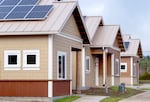Energy efficient heat pumps, electric water heaters, solar panels, home insulation, smart thermostats and lighting are all helping Pacific Northwest electric utilities and power regulators better balance the grid, according to a study out this week.
The Northwest Power and Conservation Council reviewed data from the Bonneville Power Administration and regional utilities, including Pacific Power and Portland General Electric, through Energy Trust of Oregon. That review showed an increase in cost-effective energy-efficient technology within those utilities and their partnerships. Energy efficient technologies help lower power demand and allow utilities and regulators to better forecast how much power they’ll need in order to meet energy demands in the future.

FILE - Energy Trust worked with the Confederated Tribes of Grand Ronde to build 24 energy-efficient homes for tribal elders. Technologies including electric appliances, solar panels, renewable energy storage batteries, electric vehicle chargers and heat pumps help lower demand on the grid and help cement regional energy efficiency goals.
Kristyna Wentz-Graff / OPB
The region used 160 average megawatts less because of energy efficiency in 2023, according to the Northwest Power and Conservation Council’s findings. Half of that was in the commercial sector, with 26% in the industrial sector, 19% in residential, and 5% in agriculture.
The council develops regional power plans to balance the Northwest’s energy needs. In 2021, it developed a plan for the region to achieve at least 750 average megawatts of cost-effective energy efficiency by 2027.
“We’re tracking toward the high end of the target in general, which is a good thing, because we’re also tracking toward the high end of our expectations for how much energy we would need and how much our energy demand is growing,” said KC Golden, the power and conservation council’s vice-chair, who represents Washington. “We need that saved energy in order to meet our energy needs reliably and affordably in the Northwest.”
As the shift from powering homes with fossil fuels to renewable energy continues, power regulators and utilities have a monumental task. They must determine how much renewable energy is needed to meet future demands.
Electricity use is increasing, at times, as more people are making the switch from gas to electric in their homes, with devices they use and in the cars they drive. It is also increasing due to data centers and other high-tech facilities using more electricity. That switch to electric is beginning to strain the power grid, as the region can’t add enough renewable energy to meet all demands, especially in moments like a heat wave or a cold snap when power use is high.
Energy efficiency is key to bringing balance and reducing power demand.
“It’s cheaper and it’s cleaner,” Golden said. “So, we definitely want to focus on getting those savings that are cheaper than the energy we would otherwise have to create at a new power plant.”
The Northwest Power and Conservation Council study also looked at data from Northwest Energy Efficiency Alliance and Energy Trust of Oregon.
Recently, Energy Trust worked with the Confederated Tribes of Grand Ronde to build 24 energy efficient homes for tribal elders. The homes included electric appliances, solar panels, renewable energy storage batteries, an electric vehicle charger, heat pumps and electric heat pump water heaters.
These types of technologies help lower demand on the grid and help cement energy efficiency goals, but also lower utility rates for customers, Energy Trust of Oregon’s government and stakeholder relations lead Hannah Cruz said.
Related: PGE seeks 10.9% rate hike, after record number of disconnections
Over the past five years, gas and electric for-profit utilities in Oregon have increased their energy rates drastically, with some customers paying nearly 50% more than they did in 2020. That’s creating financial hardships for some. PGE reported a record number of disconnections due to unpaid customer bills earlier this year. Its customers could see a 10% increase next year.
But it’s going to take more than adding energy efficient technologies to meet the growing demand for more renewable electricity, Cruz said. That includes adding more renewable energy, like solar and wind, as well as building more transmission lines to deliver that new power.
“There’s going to be pros and cons to each of these,” she said. “The community must be engaged in the energy choices that we’re all making. To really meet these decarbonization goals, every resource has to be considered, and I’m really glad energy efficiency is performing. But there’s more to do.”
